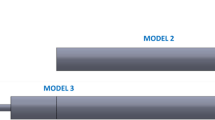Abstract
Analysis of the aerodynamic performance of high-speed trains in special cuts would provide references for the critical overturning velocity and complement the operation safety management under strong winds. This work was conducted to investigate the flow structure around trains under different cut depths, slope angles using computational fluid dynamics (CFD). The high-speed train was considered with bogies and inter-carriage gaps. And the accuracy of the numerical method was validated by combining with the experimental data of wind tunnel tests. Then, the variations of aerodynamic forces and surface pressure distribution of the train were mainly analyzed. The results show that the surroundings of cuts along the railway line have a great effect on the crosswind stability of trains. With the slope angle and depth of the cut increasing, the coefficients of aerodynamic forces tend to reduce. An angle of 75° is chosen as the optimum one for the follow-up research. Under different depth conditions, the reasonable cut depth for high-speed trains to run safely is 3 m lower than that of the conventional cut whose slope ratio is 1:1.5. Furthermore, the windward slope angle is more important than the leeward one for the train aerodynamic performance. Due to the shield of appropriate cuts, the train body is in a minor positive pressure environment. Thus, designing a suitable cut can contribute to improving the operation safety of high-speed trains.
Similar content being viewed by others
References
SUZUKI M, TANEMOTO K, TATSUO M. Aerodynamics characteristics of train/vehicles under cross winds [J]. Journal of Wind Engineering and Industrial Aerodynamics, 2003, 91(1): 209–218.
GAO Guang-jun, ZHANG Jie, XIONG Xiao-hui. Location of anemometer along Lanzhou-Xinjiang railway [J]. Journal of Central South University, 2014, 21(9): 3698–3704.
DIEDRICHS B, SIMA M, ORELLANO A, TENGSTRANO H. Crosswind stability of a high-speed train on a high embankment [J]. Proceedings of the Institution of Mechanical Engineers, Part F: Journal of Rail and Rapid Transit, 2007, 221(2): 205–225.
ZHANG J, GAO G J, HUANG S, LIU T H. Effect on measurements of anemometers due to a passing high-speed train [J]. Wind and Structures, 2015, 20(4): 549–564.
ZHANG Jie, GAO Guang-jun, LI Liang-juan. Height optimization of windbreak wall with holes on high-speed railway bridge [J]. Journal of Traffic and Transportation Engineering, 2013, 13(6): 28–35. (in Chinese)
KWONA H B, PARKB Y W, LEE D H, KIM M S. Wind tunnel experiments on Korean high-speed trains using various ground simulation techniques [J]. Journal of Wind Engineering and Industrial Aerodynamics, 2001, 89: 1179–1195.
SANQUER S, BARRE C, VIREL M D, CLEON L M. Effect of cross winds on high-speed trains: Development of a new experimental methodology [J]. Journal of Wind Engineering and Industrial Aerodynamics, 2004, 92: 535–545.
KRAJNOVIC S. Numerical simulation of the flow around an ICE2 train under the influence of a wind gust [C]// International Conference on Railway Engineering 2008. Hong Kong, China, 2008: 219–224.
CHELI F, RIPAMONTI F, ROCCHI D, TOMASINI G. Aerodynamic behaviour investigation of the new EMUV250 train to cross wind [J]. Journal of Wind Engineering and Industrial Aerodynamics, 2010, 98: 189–201.
HEMIDA H, KRAJNOVIC S. LES study of the influence of the nose shape and yaw angles on flow structures around trains [J]. Journal of Wind Engineering and Industrial Aerodynamics, 2010, 98: 34–46.
BAKER C J. The flow around high speed trains [J]. Journal of Wind Engineering and Industrial Aerodynamics, 2010, 98(6): 277–298.
ZHANG Jie, LIANG Xi-feng, LIU Tang-hong, LU Lin-feng. Optimization research on aerodynamic shape of passenger car body with strong crosswind [J]. Journal of Central South University: Science and Technology, 2011, 42(11): 3578–3584. (in Chinese)
LI Yan-fei, TIAN Hong-qi, LIU Hui. Optimization of windbreak wall with holes in high-speed railway [J]. Journal of Central South University: Science and Technology, 2011, 42(10): 3207–3212. (in Chinese)
LIU Tang-hong, ZHANG Jie. Effect of landform on aerodynamic performance of high-speed trains in cutting under cross wind [J]. Journal of Central South University, 2013, 20(3): 830–836.
LUO Jian-bin, HU Yuan-yuan, YANG Jian-heng, HU Ai-jun. Effect of embankment inclining angle on aerodynamic characteristic of high speed train under crosswinds [J]. Chinese Journal of Computational Physics, 2013, 30(5): 675–682. (in Chinese)
MIAO Xiu-juan, TIAN Hong-qi, GAO Guang-jun. Effect of railway environment on aerodynamic performance of train on embankment [J]. Journal of Central South University: Science and Technology, 2010, 41(5): 2028–2033. (in Chinese)
COOPER R K. The effect of cross-wind on trains [C]// Proceedings of Aerodynamics of Transportation, ASME-CSME Conference. Niagara, 1979: 127–151.
FLUENT Inc. FLUENT User’s Guide [R]. 2006.
Key Laboratory of Traffic Safety on Track of Ministry of Education. Research report of aerodynamic performances of trains and wind-break facilities under strong wind conditions for Lanzhou-Urumqi high-speed railway [R]. Changsha: Central South University, 2011. (in Chinese)
GAO Guang-jun, TIAN Hong-qi, YAO Song, LIU Tang-hong, BI Guang-hong. Effect of strong cross-wind on the stability of trains running on the Lanzhou-Xinjiang railway [J]. Journal of the China Railway Society, 2004, 26(4): 36–40. (in Chinese)
Author information
Authors and Affiliations
Corresponding author
Additional information
Foundation item: Projects(51075401, U1334205) supported by the National Natural Science Foundation of China; Project supported by the Scholarship Award for Excellent Innovative Doctoral Student granted by Central South University of China; Project(132014) supported by the Fok Ying Tong Education Foundation, China
Rights and permissions
About this article
Cite this article
Zhang, J., Gao, Gj., Liu, Th. et al. Crosswind stability of high-speed trains in special cuts. J. Cent. South Univ. 22, 2849–2856 (2015). https://doi.org/10.1007/s11771-015-2817-y
Received:
Accepted:
Published:
Issue Date:
DOI: https://doi.org/10.1007/s11771-015-2817-y




